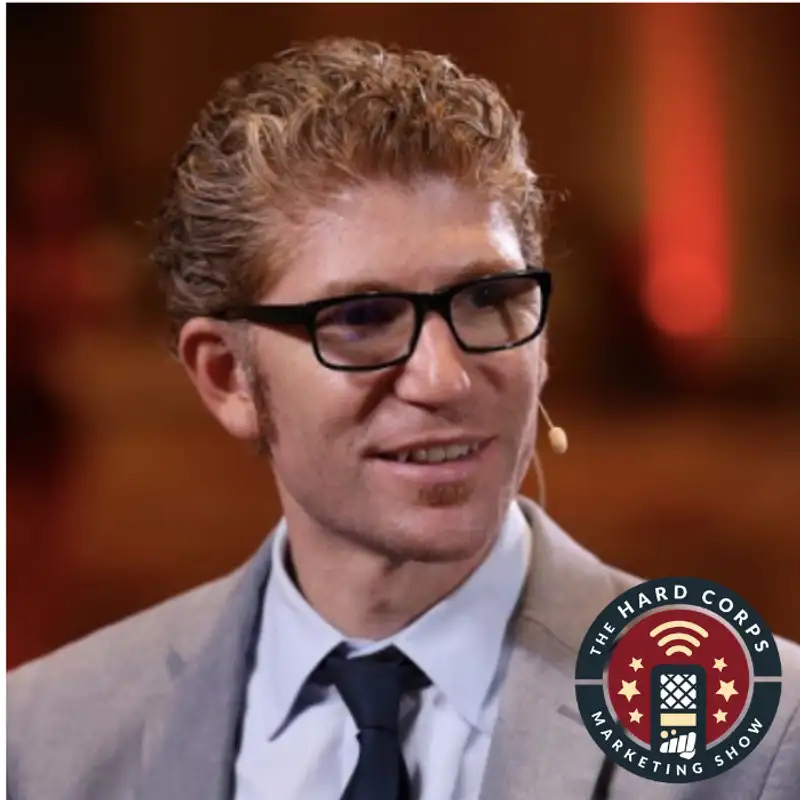
Agility Marketing - Roland Smart - Hard Corps Marketing Show #77
You’re on a boat, headed towards a waterfall and there is nothing you can do about it. You see your doom ahead and want to do something about it, but your boat just keeps sailing forward.
What if you reacted as soon as you saw the waterfall approaching? What if your were agile?
This episode is filled with strategy, history, and thought provoking questions of incorporating an agility mindset to marketing. An Author, Podcast Host, Agility Marketing Advocate, and the VP of Marketing at Pantheon Platform, Roland Smart, is our captain on the marketing ship that will keep it from diving down the waterfall.
Takeaways:
When you put a name on a concept or a process, it gives people the opportunity to rally behind it, build a community, and then create content to support it.
Agile is designed as a philosophy or approach where it’s difficult to predict the future. In marketing it’s difficult to predict many factors for example, market conditions and consumer expectation.
Waterfall is a project management method that is opposite to agile. It’s a linear process where a detailed analysis can be used to predict an outcome.
Agile starts with iterations of a process, then a demo is released of what was created, then a retrospective analysis is done of the process itself.
The retrospective considers: Was this the best way to execute this process? Should the process be changed? It causes the planners to be intentional about improving their processes.
With agile, the idea is to make small changes along the way to your process when you see the need for improvements.
Agile is a mindset that companies as a whole need to adopt in order to fully implement the model when managing projects.
The mindset allows employees that are involved in the day-to-day operations, the opportunity to come to the executive level managers, and propose ways of improving processes to better achieve the executive end-goal.
A waterfall mindset is a full top-down approach where the executive end-goals are given, the processes are dictated, and all hands keep driving towards the end goal with the same process.
You have to get used to failure if you are going to make changes to improve your processes.
It’s difficult to embrace agility if you cannot drive down the cost of making changes.
“Making small mistakes in a public way and correcting them, actually has a more significant impact on attach rate than doing something that’s brand consistent on a big scale.”-Roland Smart
Links:
LinkedIn: https://www.linkedin.com/in/rolandsmart/
Twitter: @rsmartly
Website: http://rolandsmart.com/
Pantheon Platform: https://pantheon.io/
Book: http://rolandsmart.com/book/
Podcast: https://podcasts.apple.com/us/podcast/marketing-agility-podcast/id410175356
Business Agility Institute: https://businessagility.institute/
Busted Myths
Agile Marketing is just the latest trend. There has actually been a very long tradition which started in the early 2000s with the Agile Manifesto, but software developers had already been working with the model for 10-15 years. Around 2011, marketers saw the Agile Manifesto and they adopted it to become Agility Marketing.
Taking a risk and doing an action that may be slightly inconsistent with your brandi is bad. This is not true when the risk is small, buyers react poorly, and then the company responds quickly and appropriately. It becomes an exchange between the buyers and the brand and the buyers’ attachment is greater. They are involved.
Shout Outs
Bain & Company
McKinsey Consulting
Boston Consulting Group
Drift
Peter Drucker
Business Agility Institute
You’re on a boat, headed towards a waterfall and there is nothing you can do about it. You see your doom ahead and want to do something about it, but your boat just keeps sailing forward.
What if you reacted as soon as you saw the waterfall approaching? What if your were agile?
This episode is filled with strategy, history, and thought provoking questions of incorporating an agility mindset to marketing. An Author, Podcast Host, Agility Marketing Advocate, and the VP of Marketing at Pantheon Platform, Roland Smart, is our captain on the marketing ship that will keep it from diving down the waterfall.
Takeaways:
- When you put a name on a concept or a process, it gives people the opportunity to rally behind it, build a community, and then create content to support it.
- Agile is designed as a philosophy or approach where it’s difficult to predict the future. In marketing it’s difficult to predict many factors for example, market conditions and consumer expectation.
- Waterfall is a project management method that is opposite to agile. It’s a linear process where a detailed analysis can be used to predict an outcome.
- Agile starts with iterations of a process, then a demo is released of what was created, then a retrospective analysis is done of the process itself.
- The retrospective considers: Was this the best way to execute this process? Should the process be changed? It causes the planners to be intentional about improving their processes.
- With agile, the idea is to make small changes along the way to your process when you see the need for improvements.
- Agile is a mindset that companies as a whole need to adopt in order to fully implement the model when managing projects.
- The mindset allows employees that are involved in the day-to-day operations, the opportunity to come to the executive level managers, and propose ways of improving processes to better achieve the executive end-goal.
- A waterfall mindset is a full top-down approach where the executive end-goals are given, the processes are dictated, and all hands keep driving towards the end goal with the same process.
- You have to get used to failure if you are going to make changes to improve your processes.
- It’s difficult to embrace agility if you cannot drive down the cost of making changes.
- “Making small mistakes in a public way and correcting them, actually has a more significant impact on attach rate than doing something that’s brand consistent on a big scale.”-Roland Smart
Links:
- LinkedIn: https://www.linkedin.com/in/rolandsmart/
- Twitter: @rsmartly
- Website: http://rolandsmart.com/
- Pantheon Platform: https://pantheon.io/
- Book: http://rolandsmart.com/book/
- Podcast: https://podcasts.apple.com/us/podcast/marketing-agility-podcast/id410175356
- Business Agility Institute: https://businessagility.institute/
Busted Myths
- Agile Marketing is just the latest trend. There has actually been a very long tradition which started in the early 2000s with the Agile Manifesto, but software developers had already been working with the model for 10-15 years. Around 2011, marketers saw the Agile Manifesto and they adopted it to become Agility Marketing.
- Taking a risk and doing an action that may be slightly inconsistent with your brandi is bad. This is not true when the risk is small, buyers react poorly, and then the company responds quickly and appropriately. It becomes an exchange between the buyers and the brand and the buyers’ attachment is greater. They are involved.
Shout Outs
- Bain & Company
- McKinsey Consulting
- Boston Consulting Group
- Drift
- Peter Drucker
- Business Agility Institute
Creators and Guests

Host
Casey Cheshire
CEO & Founder of Ringmaster Conversational Marketing. Casey Cheshire is a marketer, serial entrepreneur, and adventurer. He has been in EO for close to 10 years and counts his relationships as a key reason for his continued success. Casey’s passion for podcasting led to him founding Ringmaster Conversational Marketing. Ringmaster helps B2B businesses launch podcasts that drive growth and revenue. Previously, Casey founded and ran Cheshire Impact for 10 years. It became the top Salesforce Pardot marketing automation solutions partner in the world before a successful exit in 2021. He is also a US Marine Corps Veteran where he served in the Infantry and deployed to some very hot climates. In his free time, Casey likes to skydive, climb mountains, and pretend to be a hungry bear for his two kids.